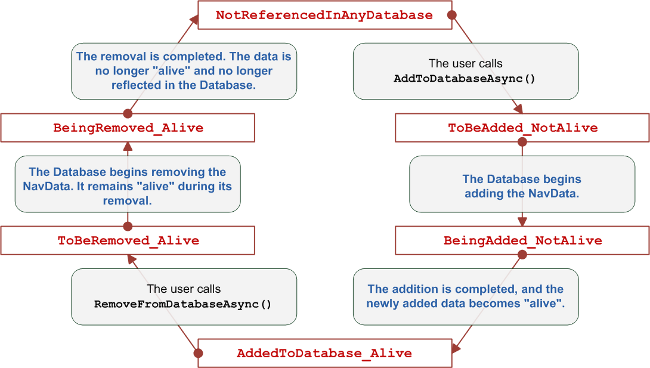Using NavData at Runtime
NavData is managed in your game at runtime through the use of one or more Databases: objects that are in charge of maintaining coherent sets of NavData for characters that share the same physical dimensions and movement models.
If you have already completed the integration tutorial in this documentation (see Integrating Navigation into your Game Engine), you should be familiar with the basic uses of a Database to load and unload NavData at runtime. This page, along with the other topics in this section, provides some additional details and considerations.
When you create a World, you must specify how many Databases that World should create and maintain. See Integration Phase 1c: Setting up a World.
Each Database can only load NavData that was created with the same set of configuration parameters. If you have characters whose physical dimensions or movement capabilities are different enough that they cannot share the same NavData, you will need to set up multiple Databases for your World. For details, see Using Multiple Databases.
The number of Databases maintained by the World cannot be changed after creating the World.
In order to add NavData for your terrain or a sector of your terrain into a Database, you must first create a NavData object, set it up with data by reading the data from a file or a memory buffer, and initialize it with the Database that will manage it.
For a code example that shows how to load from a file, see Integration Phase 3: Loading and Unloading NavData.
For a code example that shows how to load from a memory buffer, see Integration Phase 6a: Integrating NavData into your Asset Pipeline.
When you want to add your NavData to a Database in order to make it available for the path finding, path following and query systems, or to remove the NavData from the Database when it is no longer needed in the game, you have a choice of two methods: immediate or asynchronous.
This is the most straightforward way to add and remove NavData. Use the following methods of the NavData class:
KyResult NavData::AddToDatabaseImmediate(); KyResult NavData::RemoveFromDatabaseImmediate();
With this approach, a full update of the Database is immediately launched, and the calling thread is blocked until the update is complete. During this update, the new data is fully stitched into the existing NavData or fully decoupled from the rest of the NavData.
This approach has the obvious advantage of ensuring that the data that is available to your Bots and queries is always up-to-date with the latest additions or removals that you have made. However, since this approach causes the entire update to occur during the current frame, it can cause CPU peaks when used with large data sets in a real production. In addition, it requires you to be careful about multi-threading; if you are performing queries in another thread, modifying the data those queries are relying on may cause unexpected results or even crashes. It is therefore intended primarily for use during your initial integration and prototyping phases, with the expectation that you will eventually want to move to asynchronous addition and removal of data.
Note however that if you are loading your data outside of the context of a game loop, such as in a post-processing phase of your data generation process, you must use this approach.
The safe way to add and remove NavData is to use the following methods:
KyResult NavData::AddToDatabaseAsync(); KyResult NavData::RemoveFromDatabaseAsync();
With this approach, the request to add or remove the NavData is registered, and is processed in subsequent frames during the update of the World.
Once an asynchronous Database update has been triggered during a World update, further requests for NavData addition or removal in any Database in that World are only processed after the update has finished. Therefore, depending on the current state of the Databases when you request the asynchronous addition or removal, the processing may begin the following frame, or it may be delayed for several frames. NoteThis also means that for best performance, you should attempt to group all your addition and removal requests for each World, and request them all in the same frame.
- Depending on the current state of the data in the Database, and the complexity of the calculations involved (including the number of TagVolumes causing dynamic modifications to the NavMesh that need to be taken into account), the processing may be completed in a single frame, or it may be time-sliced across multiple frames.
Your only guarantee is that the Database will not reflect the new set of data until after at least one frame has passed.
The Database manages all of the complexities involved in tracking the data addition and removal processes. However, it may be useful for you to track the status of your requests, so that you know whether your Bots and queries are using the latest changes you have made to the set of NavData in the Database. Each NavData object maintains its own status value, accessible through NavData::m_databaseStatus, which indicates the current status of that NavData within its assigned Database.
The following image summarizes how these status values are set in response to addition and removal requests. The status values are shown in red, user-initiated actions in black, and internal actions in blue:

After you have removed your NavData object from its Database, you should always set any pointers you have maintained to that NavData object to KY_NULL. This decrements the reference counting mechanism.